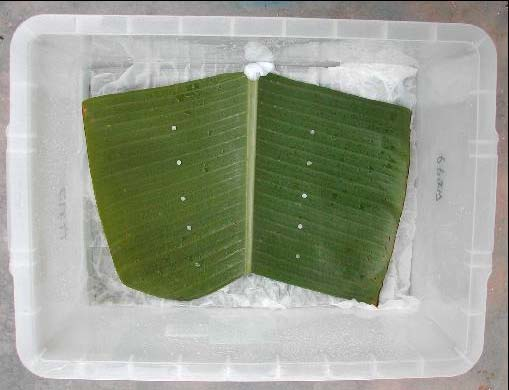
Practical Moist Chamber Incubation
Fungal leaf spot identification is accomplished by associating a fungus with the
symptoms on the foliage. Fungi are usually identified by spore morphology and spore
arrangement on conidiophores or by spore morphology and fruiting bodies observed in
the diseased plant tissue. If spores are present on symptomatic tissues, then diagnosis
may be completed with light microscopy. If spores are not present, then a moist
chamber may be prepared to stimulate spore development and maturation. After 1-7
days, tissues are examined for signs of sporulation. If spores are not produced in a
moist chamber, then diagnosis proceeds to fungal isolation in culture. After
approximately 3-7 days, culture re-examined microscopically to observe fungal spore
development.
Materials
Each team of students will require the following material
Plant samples showing leaf spots, (early blight on tomato/ Septoria leaf spot on
tomato/Cercospora leaf spot on rose/ anthracnose on cucumber) dissecting and
compound microscope, slides and cover slips, dropper bottle with water, cotton blue
satin (0.5%) plastic bags, paper towels.
Procedure
1. Select a sample (provided by instructor) for diagnosis.
2. Study and record observations of the symptoms present. Describe leaf spot
colour, shape, size, texture etc.
3. Select some leaf spots of varying appearance and observe with the aid of a
dissecting microscope. Look for evidence of small black or other coloured
bodies scattered over the leaf spots, .record observations.
4. If fruiting bodies are observed, cut out tissue sections with bodies and place one
or two sections on a microscopic slide, add a drop of water and put coyer slip.
Observe wet mount for presence o f fruiting bodies and spores.
5. If fruiting bodies are not observed, take few leaves with leaf spots and place
them onto a plastic bag containing a damp paper towel. Incubate for 7 days at
room temperature.
6. Refer to the Illustrated Genera of Imperfect (Barnett and Hunter, 1986 edition) to
identify the fungus. Consult host disease indices and compendia of crop
diseases to determine whether the fungus has been associated with a
previously reported leaf spot disease.
7. Make the diagnosis.
Observations and record
· Observe the fungus based on spore morphology, fruiting bodies, arrangement of
spores on conidiophores.
· Determine "whether the symptoms and signs observed have been previously
described on the host selected.
· Comments should be made on the diagnosis of the problem with justification.


